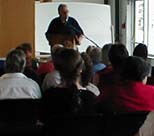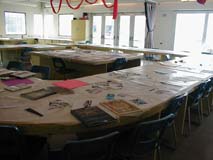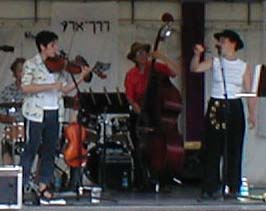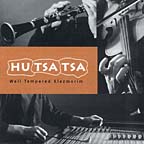Ashkenaz 2004: Wonderful stuff, but not a festival of new or Yiddish culture
Toronto's bi-annual Ashkenaz Festival is one of the most eagerly awaited Jewish music extravaganzas. It doesn't have the depth or longevity of say, Berkeley, California's "Jewish Music Festival" held every year, nor is it the once-every-350-years extravaganza taking place in New York City right now, but nowhere else in the world can one stroll around and hear so much Jewish music and Jewish language in one place, most of it for free, much of it happening all at once.
 This year, as in each of the preceding four festivals, there was no shortage of amazing music. So, I'll get to that in a minute. Instead, I'd like to spend a few minutes talking about some of the few things that felt wrong, starting with the fact that this festival, officially tagged "a festival of new Yiddish culture" contains precious little that is new, and is clearly not limited to Yiddish culture (alternately, if by "Yiddish" you mean "takes place in the Yiddish language," there wasn't much Yiddish culture at all).
This year, as in each of the preceding four festivals, there was no shortage of amazing music. So, I'll get to that in a minute. Instead, I'd like to spend a few minutes talking about some of the few things that felt wrong, starting with the fact that this festival, officially tagged "a festival of new Yiddish culture" contains precious little that is new, and is clearly not limited to Yiddish culture (alternately, if by "Yiddish" you mean "takes place in the Yiddish language," there wasn't much Yiddish culture at all).
Other than a brunch lecture about Yiddish humor, I don't believe that any events were held in Yiddish. The Ashkenaz Salon on "Should we rap in Yiddish?" was successful only in that one panelist, the alleged cultural conservative, said that he had no problem with rap in Yiddish—surely a living language would include modern music forms. His issue had to do with using "Yiddish" as a code word for "Jewish" when, say, Yiddish language was not intended. The other panelist pointed out that he was doing rap in Yiddish and had some additional examples. Perhaps a more honest panel title would have been "What does rap sound like in Yiddish?" but that would have been "new".
As this event was not Yiddish, it was also not new. The only event that I would tag as "new" in the usual cultural sense of being on the edge, was "Feast of the East", a still not-entirely-fused amalgam of Middle Eastern music and Yiddish music by the husband-wife team of David Buchbinder and Roula Said. It was an intensely wonderful program, not least for watching the incredible David Wall wail away not only in Yiddish, but on Arabic harmonies, and certainly not only for the crowded dance floor. There were other items at Ashkenaz that were new, in the sense of new-to-those-present packaging of familiar ideas, but not even the one-person play, "It sounds better in Amharic", about fitting into Israeli society as an immigrant from Ethiopia, or the shtick about Yom Kippur that was presented at one of the late night cabarets that broke conceptual ground or took any artistic or political chances, nor did any friends mention things that I missed that would have been "newer" than "new to Ashkenaz."
Truthfully, since festival co-founder David Buchbinder moved on to other things, neither the program nor the individual acts have felt as imaginative. It isn't clear to me, however, that this is a reflection on the current team, who seem to put a lot of very smart, very heimish, very good energy into making Ashkenaz exciting, as a statement about institutionalizing something that was once on the edge, but couldn't be sustained there.
I like to see at least a few things that are new: new Yiddish songwriting by folks like Josh Waletzky or Jeff Warschauer and Deborah Strauss, for instance, or new forms of music like 2002's "Hip Hop Hasene" with Josh Dolgin and Sophie Solomon and friends. But for that, if necessary, I can go to KlezKanada and KlezKamp and the other places where people making exciting new stuff gather.
But I do also have a problem with this "Yiddish culture" thing. It was my belief (but not one that I have discussed with Bruce Rosensweet or David Buchbinder or other Ashkenaz founders) that when the first festival was held in 1995, it was specifically about Yiddish culture for several reasons:
- At least one of the organizers grew up in a secular Yiddish environment, and to some extent, that was Jewish;
- At the time, the klezmer revival offered a door to a rich Yiddish culture that was seen as edgy, non-mainstream "Israel and the Synagogue" culture that secularists, and many assimilated Jews had rejected (as a friend put it, avoiding the "candle-lighting, cholent-eating bullshit");
- For some, therefore, the word "Yiddish" was a comfortable substitute for "Jewish" (as "klezmer", listed as a musical influence, was preferred by some over "Jewish", even when the musical influence was absolutely Jewish and not klezmer)
But it's 2004, and klezmer is mainstream again, and the edges are elsewhere. And as has been true at least since I first attended in 1997, the festival, this one included, embraces Jewish music that is not necessarily Ashkenazic. At this point, use of the word "Ashkenazic" in the festival description reads as "we're not comfortable claiming that we're presenting Jewish culture, so we need another name," which is the silliness that Gottesman was pointing out at that first salon on Yiddish rap.
But, not so fast. The festival may include a few dribs and drabs from other aspects of Jewish culture, but the bulk of the musical entertainment this year (as most) was klezmer. Safe, mainstream klezmer. The acts may be excellent—and damn, all of those I saw were better than excellent—but I found myself leaving after two days, having become "klezzed out", and having seen more variety, and gotten a much deeper and more exciting sense of "new Yiddish culture" in one staff concert at KlezKanada, the week before.
So, here's what I'd like to suggest. Compromise. Change the festival subtitle. Call it "A Festival of New Jewish Culture". Let's out ourselves as Jews (even acknowledging that not everyone who makes this New Jewish Culture is Jewish, anymore than all of the blues and jazz musicians at a festival of New Black Culture will be black). And instead of twenty klezmer bands, next year let's see some Sephardic music and some Judeo-Arabic music, and more Middle Eastern and/or Israeli music, or at least some stuff on the edges of all of that and the world cultures around us. It doesn't all have to be new, but let "new" be a bigger part of the experience, just as acknowledging Jewish pluralism, cultural, political, and musical could also be part of the festival. And that, really, would be worth the ten hour shlep from Boston, indeed. Or the half hour shlep from the Toronto 'burbs!
Having said all that, I just need to acknowledge some incredible things that I did see this year, and I only touched the surface. First off, while I was busy learning that one can make tepid Ethiopian Jewish comedy, a Dutch band called "Ot Azoj" played a set that almost everyone I met was talking about. Whatever they do, a wide swatch of people dug it. And even if "It sounds better in Amharic" is tepid, it was neat to hear mainstream comedy expressed through an Ethiopian Jewish perspective.
I admit to catching only the tail end of Havdalah, which sounded gruesomely banal. That was not the universal opinion of those who participated. The Klezmatics, on that opening Saturday night after Havdalah, produced the kind of all-over-the-map incredible, intense, wonderful set that renews me each time I hear them. The material covered their entire career, including some of the new Woody Guthrie material that they set to music. "Mermaid Avenue" is going to be one of my favorites just like "Man in a Hat". In recent years, I have sometimes missed concerts that I could have attended, thinking that surely I have enough live music from them in my head. Wrong. And, as I mentioned earlier, "Feast of the East," which Buchbinder and Said premiered last year at a local Toronto club, is brilliant. It isn't yet a fusion, but it is already incredibly good, high energy dance music (pick your dance: modern, middle eastern, or yiddish). This is one of the two acts, unknown in Boston, that I would and will put energy into bringing to Boston.
We missed the Ashkenaz parade the next day. I threw a snit fit about not attending a parade that consisted of marching around at Harbourfront. Back in the exciting days, when Buchbinder was running things, we gathered at Kensington Park and walked past the food stalls and old synagogues, thence down Spadina to Harbourfront making noise, watching the stiltwalkers, and showing passersby that we Jews can do a damn good parade celebrating our diversity of cultures. I don't care how good the Harbourfront-only event was, it wasn't worth interrupting pho in the Kensington Market for.
 While I attended a wonderful papercutting class led by Susan Leviton, an amazing artist and a wonderful, supportive, enabling teacher, my friends caught "Raquy and the Cavemen," one of the few non-klezmer acts. The musicians, mostly from Israel, apparently do wonderful Middle Eastern drumming mixed with modern rock instrumentation. Raquy also later led an (apparently) excellent workshop on Middle Eastern drumming.
While I attended a wonderful papercutting class led by Susan Leviton, an amazing artist and a wonderful, supportive, enabling teacher, my friends caught "Raquy and the Cavemen," one of the few non-klezmer acts. The musicians, mostly from Israel, apparently do wonderful Middle Eastern drumming mixed with modern rock instrumentation. Raquy also later led an (apparently) excellent workshop on Middle Eastern drumming.
 But I was for learning a bit about papercutting, one of the very special Ashkenazic artforms that flowered, especially in Poland before the Holocaust, and which has been revived as an artform in recent years along with klezmer and other Yiddish folk arts. Leviton talked a bit about how other European cultures also do papercutting, and showed examples, and talked of its use for common items such as mizrachim, and even as covers for children's chumashim so that they could see which side was up on the plain, cheaply bound books, and avoid putting other books on top. Some Jewish papercutting was done on parchment, but most commonly, on paper, as today. Leviton then walked through the techniques we would use: drawing the image on tracing paper, paying special attention to negative space: what is left when you cut an image out of the paper (which is what makes papercutting different from simply drawing), then taping the tracing paper to the paper that would be cut, and cutting carefully through both at once with an x-acto knife (liberally replacing blades as they became dull). Then, the finished piece would be backed with something colorful and, with the student's agreement, hung on the board with her own materials. Like typography, this is such an easy artform to learn well enough to have fun (albeit, no less difficult to master). Leviton has also taught at KlezKamp, and is the singing artist behind Singing In Yiddish / Zingendik!.
But I was for learning a bit about papercutting, one of the very special Ashkenazic artforms that flowered, especially in Poland before the Holocaust, and which has been revived as an artform in recent years along with klezmer and other Yiddish folk arts. Leviton talked a bit about how other European cultures also do papercutting, and showed examples, and talked of its use for common items such as mizrachim, and even as covers for children's chumashim so that they could see which side was up on the plain, cheaply bound books, and avoid putting other books on top. Some Jewish papercutting was done on parchment, but most commonly, on paper, as today. Leviton then walked through the techniques we would use: drawing the image on tracing paper, paying special attention to negative space: what is left when you cut an image out of the paper (which is what makes papercutting different from simply drawing), then taping the tracing paper to the paper that would be cut, and cutting carefully through both at once with an x-acto knife (liberally replacing blades as they became dull). Then, the finished piece would be backed with something colorful and, with the student's agreement, hung on the board with her own materials. Like typography, this is such an easy artform to learn well enough to have fun (albeit, no less difficult to master). Leviton has also taught at KlezKamp, and is the singing artist behind Singing In Yiddish / Zingendik!.
I caught the tail end of the "Beyond the Pale" set, which was delicious. Their new album is very special, and but for the way they rushed guest singer, Josh Dolgin, though "Halevi" so that they could get that last song in before their time was up, it was all extraordinary. On an earlier number, during the break, Dolgin does a bit of a break dance, but the real stars are the clarinet and accordion players, and, well, all of them: bass, mandolin, drums, clarinet, and accordion (and, when in the area, dolgin on vocals). And really, who in the audience would necessarily have noticed that "Halevi" was so speeded up (as opposed to that being the way he wanted to perform it) if he hadn't stopped for a second in the middle to laugh, "it's too fast!".
The highlight of the afternoon, however, was "Klezmer en Buenos Aires," a duo from Argentina that has some completely melded intensity, klezmer, and South American jazz (with much humor) that, like the Klezmatics concert the preceding day, but more so, it simply renews the spirit. Marilyn Lerner, the jazz pianist who is most familiar to Ashkenaz festival-goers as a member of the Flying Bulgars sat in with them for one number and that, too, was one of those moments that makes one glad one is there to see it live. There has to be a way to bring this band to Boston, and all over the country. It is new music to most of us, it is deeply grounded in Yiddish music, and the jazz is intensely good. Plus, just watching Cesar and Marcello live is wonderful.
I might add that I had to give up Yiddish Dancing with Helen Winkler (another high point for those who attended) to do it, but it was worth it. And having raved about Klezmer en Buenos Aires, I note that the rest of the evening was a continued high: Mikveh only gets better. I don't want to dilute the impact of the music by trying to describe it yet, again. Five extraordinary musicians and the sum is still, somehow, greater than the parts.
They were followed by Khupe, and I finally got to see Christian and Sanne play together, after marvelling at their "white album" last year. Marvellous.
And then, the Flying Bulgars, a band that has taken klezmer and jazz and Yiddish art song and made it all matter. Sometimes when I watch them I am angry that they have not gotten as much attention as the Klezmatics get—and the Klezmatics deserve all that they get and more—but anyone who hasn't seen the Bulgars live, or at least acquired a few of their CDs is the poorer for it. In a way, the Bulgars are also a bit like Brave Old World in the way that many of their compositions fit a concert stage, as here, than a dance hall. But, lest we forget, the band ended the set with some rocking, wonderful klezmer, and many in the audience obliged by dancing. This is one of the few bands that makes new Yiddish culture and, like Buchbinder's "Feast of the East" from the night before (with considerable overlap among the cast of characters and guests) or his forthcoming performances of "Shurum Burum" (an original form of which debuted at 2002's Ashkenaz Festival), amply illustrate this festival's roots at their best. I'm not sure if I agree with this description, but an old friend described the Bulgars as "Kurt Weill meets Led Zepellin." There's a lot to that description. If we were still setting 20th century Yiddish poets to music (as, now that I think of it, the Bulgars are doing), this is what the music would sound like—or is that too solipsistic?
 This is the point where I declared myself overwhelmed. Instead of staying for Zalmen Mlotek's International Cabaret, despite a promise to myself that I would kick myself in the morning for missing it, we crashed. The next morning, mindful of the long, long, long drive back to Boston and too much work awaiting me, I caught the Yiddish brunch with Professor Lichtenbaum's lecture on Yiddish humor and some unexpectedly goyish bagels, then listened to a final, delightful womyn's klezmer band, "Pomegranate" on the Toronto Star stage. (Sound on that stage, in particular, was abysmal all weekend). The group are clearly influenced by the idea of "Yiddish" as different from that mainstream "Jewish Zionist" stuff, and have the left-wing politics to prove it, but who also know how to play wonderful music. A final felafel from the "Fresser's Tent" and I was on my way.
This is the point where I declared myself overwhelmed. Instead of staying for Zalmen Mlotek's International Cabaret, despite a promise to myself that I would kick myself in the morning for missing it, we crashed. The next morning, mindful of the long, long, long drive back to Boston and too much work awaiting me, I caught the Yiddish brunch with Professor Lichtenbaum's lecture on Yiddish humor and some unexpectedly goyish bagels, then listened to a final, delightful womyn's klezmer band, "Pomegranate" on the Toronto Star stage. (Sound on that stage, in particular, was abysmal all weekend). The group are clearly influenced by the idea of "Yiddish" as different from that mainstream "Jewish Zionist" stuff, and have the left-wing politics to prove it, but who also know how to play wonderful music. A final felafel from the "Fresser's Tent" and I was on my way.
 A couple of final notes, before I sit in the car for two and a half hours, having picked the wrong border crossing on a major holiday. First, I totally missed the readings—and they were right in the community space at Harbourfront, as public and obvious as place to have people read as could be found at Harbourfront, and have no idea whether the authors were ones whose works would be new and/or exciting. For that I blame myself. But, it was easy for them to get lost. While you could pick up CDs from the artists performing from a central location, none of the bookstores with stock in the tzatchke area had books by any of the authors that I could see, nor did any of them have at the Festival, copies of Itzik Gottesman's new book, "Defining the Yiddish Nation" about the Jewish folklorists of Poland. It was great that these folks were invited to do readers; even better would have been having their works be available.
A couple of final notes, before I sit in the car for two and a half hours, having picked the wrong border crossing on a major holiday. First, I totally missed the readings—and they were right in the community space at Harbourfront, as public and obvious as place to have people read as could be found at Harbourfront, and have no idea whether the authors were ones whose works would be new and/or exciting. For that I blame myself. But, it was easy for them to get lost. While you could pick up CDs from the artists performing from a central location, none of the bookstores with stock in the tzatchke area had books by any of the authors that I could see, nor did any of them have at the Festival, copies of Itzik Gottesman's new book, "Defining the Yiddish Nation" about the Jewish folklorists of Poland. It was great that these folks were invited to do readers; even better would have been having their works be available.
And finally, at that very first salon panel about Yiddish rap, someone complained that even at Ashkenaz, yiddish was disrespected and spelled wrong. And, in truth, as I stared at the environmental signs Sunday morning, decorations designed to create that old-time Yiddish immigrant culture feel at Harbourfront, I realized that if nothing else, whoever made the signs hadn't realized that a "tzadi-sofit" is not the same thing as an "ayin". The closer I looked, those more I became convinced that the Yiddish words were transcribed from imperfect memory by someone who wasn't sure how to write Yiddish. This wasn't a new problem—the '97 t-shirt mispelled the word "magic" in Yiddish. "Derekh ere" (or "derekh error" not "derekh eretz"). The Ashkenaz brochure, which nostalgically used a font from the days of the nadir of Yiddish typography for Yiddish titling, also placed the Yiddish on the wrong side of the English when they appear on the same line. (Both Yiddish and English should share a common margin—see the Hebrew typography blog.)
 As a consolation for leaving early and missing their live set, I put the new Hu Tsa Tsa CD on the car's stereo and grooved back towards Boston.
As a consolation for leaving early and missing their live set, I put the new Hu Tsa Tsa CD on the car's stereo and grooved back towards Boston.
Comments? Questions? This doesn't have to be my rant only--join in.

